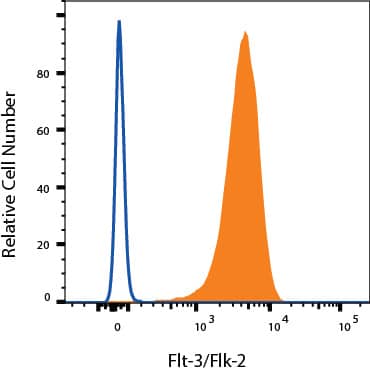Human Flt-3/Flk-2 Biotinylated Antibody
R&D Systems, part of Bio-Techne | Catalog # BAF812


Key Product Details
Species Reactivity
Applications
Label
Antibody Source
Product Specifications
Immunogen
Asn27-Asn541
Accession # AAA18947
Specificity
Clonality
Host
Isotype
Scientific Data Images for Human Flt-3/Flk-2 Biotinylated Antibody
Detection of Flt-3/Flk-2 in THP-1 cells by Flow Cytometry
THP-1 was/were stained with Goat Anti-Human Flt-3/Flk-2 Biotinylated Antigen Affinity-purified Polyclonal Antibody (Catalog # BAF812, filled histogram) or isotype control antibody (Catalog # BAF108, open histogram) followed by Streptavidin-Phycoerythrin (Catalog # F0040). View our protocol for Staining Membrane-associated Proteins.Applications for Human Flt-3/Flk-2 Biotinylated Antibody
Flow Cytometry
Sample: Human peripheral blood monocytes, THP‑1 human acute monocytic leukemia cell line
Western Blot
Sample: Recombinant Human Flt-3/Flk-2 Fc Chimera (Catalog # 368-ST)
Formulation, Preparation, and Storage
Purification
Reconstitution
Formulation
Shipping
Stability & Storage
- 12 months from date of receipt, -20 to -70 °C as supplied.
- 1 month, 2 to 8 °C under sterile conditions after reconstitution.
- 6 months, -20 to -70 °C under sterile conditions after reconstitution.
Background: Flt-3/Flk-2
The Flt-3 (fms-like tyrosine kinase) receptor, also named Flk-2 (fetal liver kinase) and Stk-1 (stem cell tyrosine kinase) is a member of the class III subfamily of receptor tyrosine kinases that also includes KIT, the receptor for SCF and FMS, the receptor for M-CSF. The extracellular region of these receptors contains five immunoglobulin-like domains and the intracellular region contains a split kinase domain. Human Flt-3 cDNA encodes a 993 amino acid (aa) residue type I membrane protein with a 26 aa residue signal peptide, a 515 aa extracellular domain with 10 potential N-linked glycosylation sites, a 21 aa residue transmembrane domain, and a 431 aa residue cytoplasmic domain. Mouse Flt-3 has also been cloned and shown to share 85% amino acid sequence identity with human Flt-3. Flt-3 expression has been detected in various tissues, including placenta, gonads, and tissues of nervous and hematopoietic origin. Among hematopoietic cells, the expression of Flt-3 was found to be restricted to the highly enriched stem/progenitor cell populations. The ligand for Flt-3 (FL) has been identified to be a transmembrane protein with structural homology to M-CSF and SCF. Recombinant soluble Flt-3/Fc chimeric protein has been shown to bind FL with high affinity and is a potent FL antagonist.
References
- Rosnet, O. et al. (1996) Acta. Haemato. 95:218.
- Drexler, H.G. (1996) Leukemia 10:588.
Long Name
Alternate Names
Gene Symbol
UniProt
Additional Flt-3/Flk-2 Products
Product Documents for Human Flt-3/Flk-2 Biotinylated Antibody
Product Specific Notices for Human Flt-3/Flk-2 Biotinylated Antibody
For research use only